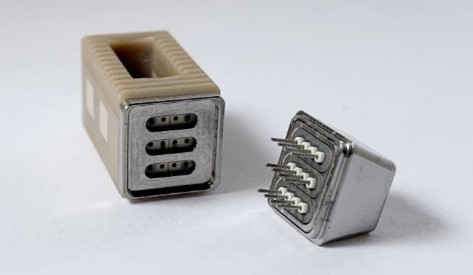
Imagine a jolt of electricity being able to grow bone from within the body. It may sound like something out of science fiction, but usually, science fiction has at least some kind of foundation in reality.
Intelligent Implants’ SmartFuse System, currently in the research and development phase, is a wirelessly enabled implant designed to remotely stimulate, monitor and control bone growth. Focusing on lumbar spinal fusion, the technology uses electrical stimulation to accelerate bone growth.
That same technology allows clinicians to remotely monitor that growth and, in turn, steer the stimulation to control bone growth — essentially causing the body to 3D-print bone exactly where needed.
“Think of it as the local drug delivery version of electrical stimulation of bone growth,” said Benjamin A. Hertzog, Ph.D., CEO of Intelligent Implants. “Electrical stimulation of bone growth has been known for many decades, but what we’ve done is taken technologies from neurostimulation and leveraged advances in microelectronics, and for the first time, we’re able to put that stimulation directly at the point of healing.”
While Dr. Hertzog and his team at the startup company envision the technology platform being applied across almost any implant in orthopedics, the initial device — the SmartFuse CAGE — is an intervertebral spacer for lumbar spinal fusion. The goal is to improve the outcomes in lumbar spinal fusion surgery: reducing failure rates while getting better fusion at a faster pace, allowing patients to get back on their feet sooner with reduced pain.
“The clinician will be able to track in real time the progress of that healing, where that new bone is being deposited, and be able to make adjustments to the therapy,” Dr. Hertzog said. “That therapeutic aspect is what’s really unique about technology like ours. It gives you information directly related to the effect of the therapy and allows a physician to intervene and dynamically adjust the therapy. There’s nothing like that out there right now.”
The Focus on Orthopedics
Dr. Hertzog said he chose to focus on orthopedics due to the many clinical needs that remain unmet in the field. Solutions are lacking, especially for high-risk patients, and room for improvement exists for patients who have problems healing.
“If you take a step back from orthopedics, if you look across medical devices in general, there’s this idea that smart connected implants and data will allow us to do a lot of things that we’ve never been able to do before and will ultimately lead to better outcomes for patients,” he said. “We’ve seen this shift in other fields, and now I think it’s time for orthopedics.”
While technology exists to remotely monitor mobility and healing, at this point, it is purely data collection without the additional therapeutic benefit, according to Dr. Hertzog.
“In orthopedics, there is no smart implant that is delivering a therapy,” he said. “As engineers and clinicians, we’d love to have that data; that will ultimately allow us to improve outcomes for patients. The struggle from a business perspective is that a lot of that value gets created later, yet we’re asking payors and clinicians to put in these more complex — and therefore likely more expensive — devices now.”
This disconnect in timing complicates the issue. Who will pay for more expensive, complex devices now when most of the value gets created later?
“Since our device has this therapeutic foundation, if we can accelerate bone growth and improve healing, that value is immediate,” Dr. Hertzog said. “We can directly measure the impact of that therapeutic benefit and make adjustments to it. That’s new, and I think that’s the future of medical devices in all fields, not just orthopedics.”

Focusing on lumbar spinal fusion, the SmartFuse System uses electrical stimulation to accelerate bone growth.
Future Possibilities
Intelligent Implants has already considered adaptations to the technology that would enable it to be implanted elsewhere, such as hips, knees or intramedullary rods. Since the electronics in the SmartFuse CAGE have been miniaturized to the point where it’s less than one cc of volume, the possibilities are nearly endless.
“Any situation in which we have patient populations and clinical situations where we have trouble getting the bone to heal or need to track the progress of that healing and be able to make adjustments to the therapy, we could do that,” Dr. Hertzog said. “Specific examples are in trauma cases where you have huge bone defects that you need to get to grow. When you think about hips, and you’ve got a patient population that’s osteopenic or osteoporotic and it’s hard to get them to grow in, you can use our technology to grow and strengthen bone. I see lots of applications in orthopedic implants where there just hasn’t been a lot of innovation in a long time.”
The Next Steps
For the next 18 months, the team at Intelligent Implants is focused on getting the SmartFuse System into the clinic for the first time. This means taking its animal prototype system that has delivered results in large animal studies, and converting it for use in a human clinical trial.
“This is a very typical transition point for a startup company,” Dr. Hertzog said. “There’s a lot of product development, spending time with FDA and other regulatory bodies to understand the preclinical testing that’s going to be required to do this and do it safely.”
He estimated that the first human trial will happen in the next 24 months.
“I’m expecting orthopedics to catch up to some of the other fields like cardiology,” he said. “It’s time for some major changes in innovation and rethinking how we do things. This evolution to smart connected devices, this ability to link diagnostics and therapeutics, I think that’s how we move the needle in patient outcomes.”
HT
Heather Tunstall is a BONEZONE Contributor.




